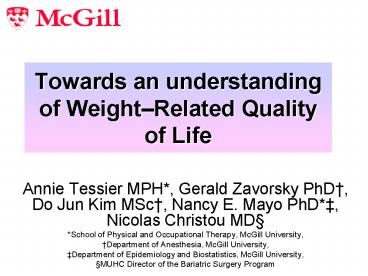Towards an understanding of WeightRelated Quality of Life PowerPoint PPT Presentation
1 / 23
Title: Towards an understanding of WeightRelated Quality of Life
1
Towards an understanding of WeightRelated
Quality of Life
- Annie Tessier MPH, Gerald Zavorsky PhD, Do Jun
Kim MSc, Nancy E. Mayo PhD, Nicolas Christou
MD - School of Physical and Occupational Therapy,
McGill University, - Department of Anesthesia, McGill University,
- Department of Epidemiology and Biostatistics,
McGill University, - MUHC Director of the Bariatric Surgery Program
2
Abstract
3
Background
- The success of weight loss programs is often
disappointing especially in the long term (20
success) - Emerging approach to enhance quality of life in
the presence of excess weight - Weight explains 30 of the variance of Weight
Related Quality of Life (WRQL) - WRQL is determined in part by age, gender, race,
pain and other health consequences of obesity and
weight-related stigma, especially for women - What are the other determinants of WRQL?
4
Objective
- To identify the determinants of WRQL and the
relationship between these determinants - The understanding of WRQL would allow us to
better measure it and to target our interventions
to reduce the impact of weight and improve the
quality of life of people with obesity
5
Methods
- Design
- Cross-sectional
- Data source
- 42 patients awaiting surgery for obesity in
Montreal - Measures
- Respiratory function
- Vo2, PAO2, PaO2, SaO2, AaDO2,VE, HR
- Physical function
- 6MWT
- HRQL WRQL
- SF-36, IWQOL
6
Statistical Analysis
- Path analysis
- In the same family as structural equation
modeling except no latent variable - Simultaneous modeling of several relationships
between variables. A variable can be a dependent
variable in one relationship and an independent
variable in another. - Need an underlying theoretical model
- MPlus statistical program used
7
Results
- Age 40 years
- Women 60 of the sample
- BMI 51kg/m2
- Waist circumference 140 cm
- PaO2 rest 88mmHg (norms 80-100)
- 6MWT 420 meters (60 of age-predicted)
- Mental Component Scale, SF-36 44 (norms51)
- Physical Component Scale, SF-36 34 (norms52)
- IWQOL-Lite converted 46/100
8
Results
- For both women and men, as waist circumference
increased, PaO2 at rest decreased. As PaO2 at
rest increased the distance walked in 6 minute
increased. 6MWT was positively associated with
physical functioning, which in turn was related
to quality of life. Mental health is associated
with better quality of life
9
Men More Fit but Poorer Gas Exchange
Abbreviations BMI, body mass index WHR, waist
to hip ratio 6MWT, 6 minute walk
test p-value for the statistical difference
between men and women
10
Men Women Differed on WRQL
p-value for the statistical difference between
men and women
11
Impact of 6MWT on IWQOL greater for MEN than women
IWQOL
6MWT
The regression equation and characteristics of
the model are In men IWQOL 31.62 0.53MWT R2
0.06 Adjusted R2 -0.01 RMSE 24.75 In
women IWQOL 28.11 0.03MWT R2 0.01 Adjusted
R2 -0.03 RMSE 22.08
12
Impact of mental health on IWQOL greater for
WOMEN than men
100
90
80
70
60
?Men Women
IWQOL
50
40
30
20
10
0
0
10
20
30
40
50
60
70
MCS
The regression equation and characteristics of
the model are In men IWQOL 31.47 0.48MCS R2
0.04 Adjusted R2 -0.03 RMSE 24.59 In
women IWQOL -8.01 1.01MCS R2 0.29 Adjusted
R2 0.25 RMSE 16.23
13
Wilson-Cleary Model Relationships among
clinical variables and Health Related Quality of
Life
14
The Determinants of WRQL by Gender
The coefficients with the purple arrows are for
analysis on the whole sample, the coefficients
with the blue arrows relate to men alone, and
the coefficients with the pink arrows are for
women alone.
15
Conclusions
- The analysis combining both genders suggests that
interventions to improve the quality of life of
obese people should target the improvement of
respiratory functions, exercise capacity, and
physical function - There appears to be some difference by gender
the WRQL of men being mostly affected by physical
factors, while the WRQL of women is also impacted
by mental health - Discrete path analysis to model the determinants
of quality of life for women and men separately
is required possibly due to different fat
distribution pattern
16
Rehabilitation Professionals will have to
- Adapt their interventions for the obese
population - The interventions may need to be different for
women and men - Manage disability primarily caused by excess
weight - Translate knowledge about function, disability
and quality of life to meet the needs of
Canadas epidemics
17
Role of rehabilitation professionals
18
Limitations
- Generalizable to morbidly obese only
- Exploratory model
- Sample size for Path analysis was small
- Full spectrum of measures not available
- Will be validated in larger and richer data set
19
Men Women Differed on WRQL
Abbreviations IWQOL, Impact of weight on quality
of life-Lite. p-value for the statistical
difference between men and women
20
- Traditional approach
- Only 20 of overweight individuals are successful
at long term weight loss - Emerging
- Weight-Related Quality of Life (WRQL) a term
being developed that incorporates the impact of
weight on an individuals ability to live a
fulfilling life (Adapted from Bullinger)
21
Effect of Weight on WRQL differ
- Even among those who lose weight, many continue
to have an impaired WRQL - Some morbid obese have great WRQL, while some
mild obese have poor WRQL - Weight explain 30 of the variance of WRQL
- What are the other determinants of WRQL?
22
The determinants of WRQL
The values correspond to regression coefficients
taking into account the other relationships in
the path
As waist circumference increased, PaO2 at rest
decreased. As PaO2 at rest increased the distance
walked in 6 minute increased. 6MWT was positively
associated with physical functioning, which in
turn was related to quality of life. Mental
health is associated with better quality of life
23
(No Transcript)

